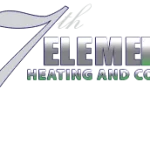Is the Air in Your Home as Clean as You Think?
As a homeowner, you dedicate yourself to creating a safe and comfortable sanctuary for your family. You choose safe paints, non-toxic cleaners, and healthy foods. But what about the very air you breathe every day? Indoor air can be surprisingly more polluted than outdoor air, holding onto allergens, dust, viruses, and chemicals. This guide explores how an indoor air purification system can elevate your home’s health, creating a truly clean environment for your loved ones.
Understanding Indoor Air Quality (IAQ) and Its Impact
Indoor Air Quality, or IAQ, refers to the air quality within and around buildings and structures. It directly relates to the health and comfort of the occupants. Poor IAQ can lead to a range of issues, from minor irritations like headaches and allergy flare-ups to more significant long-term health concerns. For families, especially those with young children, the elderly, or members with respiratory conditions like asthma, maintaining excellent IAQ is not a luxury—it’s a necessity.
Common sources of indoor air pollution include:
- Particulates: Dust, pet dander, pollen, and smoke particles.
- Biological Contaminants: Mold spores, bacteria, and viruses that thrive in ductwork and humid environments.
- Volatile Organic Compounds (VOCs): Gases emitted from cleaning products, furniture, paint, and building materials.
- Odors: Lingering smells from cooking, pets, or smoke that embed themselves in your home.
These contaminants circulate through your home’s HVAC system, meaning they are constantly being redistributed into the air you breathe. While standard furnace filters capture some larger particles, they are often insufficient for trapping the microscopic threats that impact your family’s health.
How Do Whole-Home Air Purification Systems Work?
Unlike portable, single-room air purifiers, a whole-home system integrates directly into your existing HVAC installation. This allows it to clean the air in every room that is heated or cooled. As air circulates through your system, it passes through an advanced filtration unit, neutralizing contaminants before they ever reach your living spaces. There are several effective technologies available:
Media and HEPA Filtration
High-efficiency particulate air (HEPA) filters and other advanced media filters are the gold standard for removing airborne particles. They are designed to capture at least 99.97% of dust, pollen, mold, bacteria, and any airborne particles with a size of 0.3 microns. This is incredibly effective for families concerned with allergens and dust.
UV (Ultraviolet) Air Purifiers
UV air purifiers use short-wave ultraviolet light to inactivate airborne pathogens and microorganisms like mold, bacteria, and viruses. As air passes through the UV lamp installed within your ductwork, the light disrupts the DNA of these contaminants, rendering them harmless. This technology is particularly valuable for preventing sickness from spreading through the home.
Electronic Air Cleaners
These systems use an electrostatic charge to attract and trap airborne particles. Contaminants are drawn to collector plates, which can be washed and reused. They are highly effective at removing fine particles that can pass through standard filters.
Did You Know?
The EPA reports that indoor levels of some pollutants can be 2 to 5 times higher—and occasionally more than 100 times higher—than outdoor levels. A whole-home air purification system works alongside your existing HVAC system to continuously filter the air throughout your entire home, not just one room.
The Tangible Benefits for Your Family’s Health and Comfort
Investing in an indoor air purification system provides peace of mind and tangible improvements to your daily life. Homeowners who install these systems often report:
- Reduced Allergy and Asthma Symptoms: By capturing pollen, pet dander, and other allergens, air purifiers can significantly lessen seasonal and chronic respiratory issues.
- A Cleaner, Fresher Smelling Home: The system helps neutralize odors from pets, cooking, and VOCs, leaving your home smelling clean without the use of artificial fragrances.
- Enhanced HVAC System Efficiency: By trapping dust and debris before it can build up on your HVAC components, an air purifier can help your system run more efficiently and potentially extend its lifespan. This is a key benefit reinforced by our HVAC maintenance plans.
- Improved Humidity Control: When paired with a whole-house humidifier, an air purification system can help create the perfect balance of clean and comfortable air, especially during Idaho’s dry seasons.
Air Purification Technologies at a Glance
| Technology Type | Best For Removing | Key Advantage |
|---|---|---|
| Advanced Media/HEPA Filters | Allergens, Dust, Pet Dander, Pollen (0.3 microns+) | Extremely high capture rate for particulate matter. |
| UV Air Purifiers | Viruses, Bacteria, Mold Spores | Inactivates and neutralizes microorganisms. |
| Electronic Air Cleaners | Fine Particles, Smoke, Dust | Reusable collector plates mean less waste and no filter replacement costs. |
The Local Angle: Why Eagle Homes Benefit
Living in beautiful Eagle, Idaho, we enjoy fresh air and scenic landscapes. However, our local environment presents unique challenges to indoor air quality. Seasonal pollen from trees and agriculture can be a major issue for allergy sufferers. Furthermore, smoke from regional wildfires can settle in the Treasure Valley, bringing fine particulate matter into our homes that standard filters can’t handle.
An indoor air purification system is an effective, modern solution to combat these local air quality threats. It provides a reliable defense, ensuring that when you close your door, you are truly shutting out the pollutants and creating a healthy haven for your family year-round. From managing seasonal allergies to protecting your lungs from smoke, it’s a proactive step toward a healthier home life in Eagle. This is especially true for families in newer or recently remodeled homes where tighter construction can trap indoor pollutants.
Ready to Improve Your Home’s Air Quality?
Your family deserves to breathe the cleanest, healthiest air possible. At 7th Element Heating and Cooling, we specialize in providing trusted, high-quality indoor air solutions for homeowners in Eagle and across the Boise area. We’ll help you select and install the perfect indoor air purification system for your needs, without pressure or unnecessary upsells.
Let us help you make your home a true sanctuary of health and comfort.
Frequently Asked Questions
1. How is a whole-home air purifier installed?
A whole-home system is installed by a certified HVAC technician directly into your central heating and cooling system’s ductwork, typically near the indoor air handler. The installation is clean, efficient, and ensures that all air passing through your HVAC system is treated.
2. Will an air purifier make my energy bills go up?
Modern air purification systems are designed to be energy-efficient. While they do consume some electricity, the amount is minimal. In fact, by keeping your HVAC system’s coils and components cleaner, an air purifier can help it run more efficiently, potentially offsetting its own operating cost over time.
3. What kind of maintenance do these systems require?
Maintenance varies by type. Media filters need to be replaced periodically (typically every 6-12 months), UV lamps need replacement every 1-2 years, and electronic collectors need to be washed. This simple upkeep is often included in our comprehensive preventative maintenance plans.
4. Can an air purification system help with pet smells?
Absolutely. Air purifiers with carbon filters are particularly effective at adsorbing and neutralizing the organic compounds that cause pet odors, as well as smells from cooking and smoke, leading to a much fresher indoor environment.
5. Is an air purifier a better choice than a humidifier?
They serve different but complementary purposes. An air purifier cleans the air of contaminants, while a whole-house humidifier adds necessary moisture to combat dryness. For optimal indoor comfort and health, especially in Idaho’s dry climate, using both is often the best solution.

